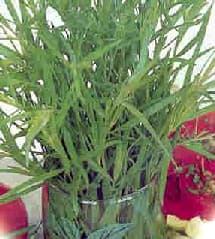How to Grow Tarragon Herb Plants

About Growing Tarragon Plants in Your Herb Garden
Tarragon plants are native to dry, rocky areas of Northwest U.S., Russia, and Asia. It is closely related to U.S. Sagebrush. Tarragon herbs thrive in poor, dry, barren soils in areas with warm days and nights. This guide describes how to grow tarragon, It is a great addition to your herb garden.
The leaves of this aromatic and culinary herb, are thin and blade-like, with a pointed tip. It produces drooping flowers in mid-summer.
Tarragon is grown for its aromatic leaves that are used in a variety of culinary recipes, most notably in flavoring vinegar.
Flowers Bloom: Summer
Flower Colors: Dull yellow, yellow-orange.
Plant height: 2 to 3 feet tall.
Hardiness Zones: 4 – 9
Artemisia Dracunculus
Medicinal and Culinary Uses
Medicinal Uses:
This herb stimulates the appetite and digestive process. An infusion or tea made of Tarragon eases flatulence and intestinal distension. (I’m all for that)
Culinary Uses:
Tarragon is a popular culinary herb, most notably in French cuisine. Tarragon is best known for flavoring vinegar. But it is also used to spice up salads, meats, vegetables, sauces, mayonnaise, cheese, and omelets. Also, Tarragon herbs to help to take the fishy taste out of …….fish.
Did you Know? Tarragon is used in making Dijon Mustard
How to Propagate Tarragon Plants
Tarragon is most commonly grown from the division of the roots. You can also propagate it by rooting small, vigorous cuttings in the spring. True French Tarragon is not grown from seed. It is a root variety, with a strong aromatic value.
Some varieties you can grow from seed are commonly carried by seed suppliers. The most popular are Russian and Sweet Tarragon. These varieties are less aromatic than root varieties but have a great culinary quality.
Days to Germination: 10 – 14 days.
Final Plant Spacing: Space seedlings, or thin plants 10 to 12 inches apart, in rows 2 feet apart.
Days to Maturity: 80-90 days
How to Grow Tarragon Herb Plants
Being native to prairies, and rocky, barren environments, Tarragon is at home, growing in the poorest area of your garden. It needs full sun. They prefer dry, rocky or gravel, or sandy soil.
The plants need a warm, dry environment, both day and night. Start seedlings indoors well before the last frost in your area. Transplant seedlings outdoors when the weather warms, spacing them 1 1/2 to 2 feet apart.
Once started, the plants grow well with little or no attention. Fertilizer always helps but is only necessary for the poorest of soils.
Allow the soil to dry between watering. Tarragon will do best if the soil is slightly dry.
Harvest and dry the leaves and flowers. Store them in a cool, dry place. Tarragon leaves can also be kept in the freezer.
Ideal pH: 6.5- 7.5
Harvesting and Drying Stevia Leaves
You can harvest Stevia leaves as soon as there is enough to use. Pick leaves in the morning, when sweetness is at its maximum.
Pick leaves before the plant begins to flower, as the leaves then turn bitter. Pinching off flower blooms, as soon as they begin to appear, prolongs the harvest.
Harvest the entire plant in the fall before the first frost. Hang plants upside down to dry, in a well-ventilated area. After they are dry, remove the leaves. You can also use the tender, young growing tips. More on Drying Herbs
Use a coffee grinder to powder the dried leaves. Store powdered leaves in an air-tight container.
Insect and Plant Disease Problems
Related Articles
Please support our site. Shop for:
- rmmatthews100@hotmail.com
- 585-721-6528
- Rochester, NY
©1999-2024 GardenersNet.Com, All Rights Reserved

